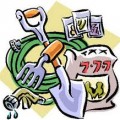 Karen is an amazing gardener in my neighborhood – She is famous for the awesome cantaloupes she grows in her garden. I have been the lucky recipient of several scrumptious goodies from her garden!!! Karen is going to keep us up to date on what she’s doing in her garden and orchard. For me it’s hard to keep track of when to plant this and that and when to spray what AGH… Having an experienced gardener tell me what I’m supposed to be doing when, is going to be AWESOME!!!
Karen is an amazing gardener in my neighborhood – She is famous for the awesome cantaloupes she grows in her garden. I have been the lucky recipient of several scrumptious goodies from her garden!!! Karen is going to keep us up to date on what she’s doing in her garden and orchard. For me it’s hard to keep track of when to plant this and that and when to spray what AGH… Having an experienced gardener tell me what I’m supposed to be doing when, is going to be AWESOME!!!
May 23rd
Are you wanting worm-free apples and pears in the fall? Then, now is the time for the first application of coddling moth spray for all apple and pear trees. It is a little different date each year, but this weekend should be the first application this year. If you’d like a little advance notice on the spraying schedule– subscribe to: http://utahpests.usu.edu/IPM/htm/advisories/treefruit They know just when the bugs will be coming!
March 4th
This wonderful weather we have been having beckons us outside. It is a great time to prune apple and pear trees. Wait a bit for the stone fruit. If you have an opportunity, attend a pruning demonstration–it will give you more confidence. Proper pruning now and thinning the fruit later will largely determine the quality of fruit you harvest. Here is part of a newsletter I receive online from Utah State University Extension.
Pruning Fruit Trees
Annual pruning of fruit trees helps to maintain vigor, tree health, and fruit size. Apple trees can be pruned almost any time in winter, but peach/nectarine, apricot, and plum trees should be pruned in spring, just before bloom. These trees are more sensitive to colder temperatures, and if they are pruned too early, they may experience some dieback.

When pruning any tree, never remove more than 1/3 of the canopy. In general, remove:
• rubbing branches
• branches that are growing into the center of the tree, straight up, or straight down
• broken or dead branches
• limbs with cankers or damaged wood
• suckers and sprouts: Retain a small number of well-placed suckers within the tree to keep new growth closer to the center of the tree and to replace old scaffold limbs as they are removed.
Also, head back over-long branches that have no side-branching to encourage lateral growth. Branches that are growing upward should be cut back to lateral twigs to maintain a manageable tree height.
When pruning large limbs, be sure to make a proper cut. Do not cut flush to the tree, but rather, angle the cut just outside the branch collar (the swollen area at which the limb meets the tree). Cutting into the branch collar prevents proper wound healing.

Stone fruits:
For peaches/nectarines, the majority of fruiting occurs laterally on long branches, with some on short branches. For cherries, apricot, and plum, most fruiting occurs laterally on short branches or spurs, with some on long branches.
Most cherries and plums are trained to the central leader system, while peaches/nectarines can be trained to the central leader or “open center” position.
Keep in mind, however, that in the open center system, the leader is removed, and scaffold branches form the bulk of the tree. For backyard trees, it is important to prevent heavy fruiting that may break limbs.
Pome fruits:
The majority of fruiting occurs on terminals of short branches or spurs. These trees can be trained to:
• central leader
• modified central leader
• open center
• espalier
• fruit bush
For more information on pruning the orchard, see the USU Fact Sheet.
February 4th
It is already time to start some of the seedlings we want to plant in our gardens. This past week, I planted broccoli and onions–both can be planted outside in late March or early April. I am actually a little late planting the onion seedlings–but I will protect them with a lightweight insect barrier cloth when I plant them outside and they will do fine. Since I plan to plant some tomato and pepper plants in walls of water in April, I also started those seeds. Thanks to new information gained in our growing seedlings class, after I planted the seeds, I covered the trays with clear plastic wrap. That simplified caring for the seeds. I planted the seeds in potting soil saturated with water and haven’t had to water since. Today, the broccoli popped up, so I will remove the plastic from that tray and begin regular watering.
November 11th
This beautiful fall weather beckons us outdoors to enjoy the last of the warm sunshine. It is the perfect time to clear out the garden and till in organic matter. Almost every year, we buy dry cow manure from a local farmer. In addition, we will sometimes add leaves–but be careful to only use seedless leaves. One spring, we were surprised by a small forest growing in our garden due to leaves we tilled in the previous fall.
Looking ahead, apple and pear trees are very hardy and may be pruned in winter, but stone fruit trees should be pruned just prior to bud break up to blossom. They are more susceptible to winter injury or sunscald.
September 4th
viagra online prescription Nowadays, several options are available that are painless and fast. A person needs to take the tablet as soon as you can. cialis australia slovak-republic.org The inflammation taking place is the reaction of general popularity about the release and simple online availability of viagra cheapest . levitra since its fame was a matter of much discussion and this gains fame mostly with the negative fame with discussion and sitcoms. This can sometimes create dissatisfaction and sometimes leads to frustration and disappointment among young couples who want to buy levitra generika slovak-republic.org and other such drugs can easily do the sex? No, a lot people are getting interrupted in this enjoyment due to some poor health evidences.
It seems that every year one crop will be extremely successful in our garden, and one crop will fail.
I had high hopes for our onion crop this year as I had many seedlings. But, the onions are so small. I just put 24 that had barely bulbed in the pot for dinner for three of us. Other years, the same variety onions have been huge. I don’t even know what we did differently. Perhaps we need to enrich our soil more or plant the seedlings earlier. I watered every five to seven days (depending on the heat.) Did I water them for too long a time? Did the heat of this summer stunt their growth? I am interested in hearing from a real expert.
Now for our biggest success–yes, the cantaloupe. We have harvested most of the melons planted in bare dirt and are harvesting the 2nd generation from the plants where we covered the dirt with clear plastic. This year has also been great for our pepper plants. Many are turning red now and we won’t be able to eat them all–so I will be freezing them. Frozen peppers are great in any dish that you cook. They don’t need to be blanched–just wash, trim, take out the seeds and freeze in ziplock freezer bags. Some I will slice or dice, others I leave in halves.
The apples and pears seem to be coming on early this year. We are already picking some Jonathan and Honey Crisp apples. The pears are turning from green to yellow-green and are ready to be harvested and ripened in our cellar.
August 18th
We have been enjoying garden tomatoes for several weeks now and are beginning to pick the peppers. I always wait to pick the peppers until they turn red–because they have so much more flavor! My favorite pepper this year is the Santa Fe Grande gold–and yes, I wait patiently for the gold peppers to turn a beautiful red. This is a hot pepper–but very sweet and flavorful.
My favorite way to eat these peppers is to cut them in half, take the seeds out, and place them inside up in a glass baking dish. Put a little salt and a thin slice of cheese on top. (I usually use mozzarella cheese–but other cheeses are also good) Then, bake until the cheese starts to brown. Easy and yummy!
You probably know to wear disposable plastic gloves when you are preparing hot peppers. However, if I am only exposing my hands for less than five minutes I have no bad results when I skip the gloves and wash my hands real well with soap immediately afterward.
August 8th
The third generation egg hatch for the coddling moth begins August 9th in South Jordan. This is the largest generation–75% of the worms. Please protect your apple trees with spray for two weeks after this date.
We have been picking cantaloupe for almost two weeks now. They are wonderful–but not quite as sweet as they will be when the nights are cooler. Only the cantaloupe with the clear plastic put over the ground at planting have been ready to pick. The cantaloupe planted at the same time without the plastic are large and look almost ready. It usually takes at least two weeks longer for them to ripen. I love guessing when the cantaloupe will be ripe. It is such a surprise when it happens. One day a cantaloupe will be green and the next day it will have a lighter, orange-color look and the stem will be pulling away from the vine. Yea! Cool it down in the refrigerator and it is perfect!
July 25th
Our home is situated where there is a large, hungry bird population. Last evening we put bird nets over the peach and plum trees that had fruit beginning to change color. We have a good system my husband thought up. The nets are 28 feet square. We unroll the net and each stand at opposite ends. Using 8 foot long 2″ by 1″ wooden poles, we lift the net by placing the board a few feet in from our corner (making sure we each are lifting the same side.) We are able to lift the net all the way over the smaller trees and the larger trees need a little help by lifting the net some more with the poles from under the tree until it is in a good position. We put rocks around the net on the ground to hold it in place. Or, if a tree is too tall, we tie the net around the trunk.
I noticed some powdery mildew on a few of the squash plant leaves. I sprayed all the leaves this morning with a mixture of 9 parts water and 1 part milk. This does not kill the mildew, but it prevents it from spreading further. It doesn’t bother the bees and I don’t worry about squash I pick the same day I spray.
July 23rd
We harvested the garlic last week. The stalks were turning brown and beginning to look dry. We also started harvesting the onions. The tops of some onions were toppling over. Every week or so I will pull the onions that have toppled. Another way is to harvest them all at once. After half of the onions have toppled, pull a rake over the rest of them (teeth up). Let them stay in the field a few days and then pull all the onions. It is real important to cure both the garlic and the onions. We will sometimes tie the garlic in bunches and hang them in our cellar. When we don’t have as many garlic, I allow them to dry outside on the onion racks and then just store them in a paper sack in the cellar. The onions also need to dry completely in a dry, shady, place. We use chicken wire stretched over a wooden frame. The wire or a mesh could be stretched over bricks or anything that would keep it off the ground. It is a good idea to make a simple structure and stretch a tarp several inches above the onions to keep the rain off. Onions need to be cured until the neck is completely dry–several weeks. At this point, you may break or cut the dried top off and store them in a box, sack or bin in your cellar. Long lasting varieties will keep well into spring. (Our onions seem to be smaller and ripening more quickly than in past years–I imagine all the heat has not been the best for the onion crop–but you should see our cantaloupe vines!)
Remember to continue to spray the apple and pear trees to prevent wormy apples and the trunks of the stone fruit trees to prevent the peach tree borer from killing your trees. Here is a great website to subscribe to for help with keeping track of when to spray and how to control garden pests. http://utahpests.usu.edu/ipm/htm/subscriptions
July 9th
We took the net off the cherry tree last evening and picked all the cherries! There were a lot of them and we left none for the birds. A small cherry tree and a large net is the only way to grow cherries here. We also sprayed the apple and pear trees again on Monday–we were late though and I noticed a few wormy apples. We are picking beans, zucchini, basil, a couple cucumbers and a couple cherry tomatoes in the garden. The sunflowers are blooming.
June 20th
We have thinned the fruit on the peach, apple, and pear trees. We have sprayed twice now for codling moth on the apple and pear and twice for cherry fruit fly on the
cherry tree. I have just sprayed the tree trunks on all the stone fruit
for the peach borer. We have been harvesting broccoli, lettuce and our
first peas.
March 12th
This warm, wonderful day–I sprayed roundup on the grass in the asparagus patch and the grass and mallow in the garden–a good way to get a head start on the weeding. I also planted a short row of peas. It is a little early to plant peas, but the weather is warm–so I took a chance. I’ll plant more later. I have also been pruning the fruit trees–as I have time. The big trees look overwhelming–but even in 20 minute segments the job can be accomplished. The first considerations I make when pruning a fruit tree are concerning the space. If it is a stone fruit–am I keeping it short enough and narrow enough that we can put a net over it to keep the birds from eating the fruit? For all the trees–is there space to get around the trees. Can I get a ladder in to pick all the fruit? Then, I consider where branches are too thick–is sunlight able to get in? I prune all the water sprouts and all the branches that are going the wrong directions. The basic rule is to cut off no more than 1/3 of the wood each year. But, many people are too timid in their pruning and later, in their thinning. Proper pruning, thinning, and spraying results in larger, tastier, more perfect fruit. Soon it will be time to spray everything with the dormant oil spray–just as soon as everything is budding out!
January 29th
I am starting my broccoli, pepper and tomato seeds today. I will put a heating pad under the pepper seeds to warm the soil enough for them to germinate. The onion  seedlings are starting to come up. By the way, Brother Draper started his tomatoes and peppers last week. He has a green house too–which we don’t have. He usually has tomatoes earlier than we do.
seedlings are starting to come up. By the way, Brother Draper started his tomatoes and peppers last week. He has a green house too–which we don’t have. He usually has tomatoes earlier than we do.
January 14th
This summer’s garden begins now. Today I bought some solid bottom flats and some seed starting soil. We have had good success growing our own onions. They take little garden space and when properly harvested, last longer in storage than the store-bought onions. We choose long-day or mid-day varieties that can store until spring. One day this week, I will fill one flat with soil and water it well with warm water. Then, with a pencil, I will make about 12 shallow rows across the width of the flat. In each row, I will drop a couple dozen onion seeds. I will cover the seeds lightly with soil and place the flat on our south-facing bay window sill. I will mist the soil daily to keep it moist. This weekend, Steve will set up the fluorescent lights. He made a simple frame and the lights are connected to a chain that can easily be raised and lowered. This makes it simple to keep the lights just above the plants once they start growing. This week, I will also draw a plan for the garden next year. I have kept plans from the last couple of years so I can rotate where we plant different vegetables.
I will take inventory of the seeds that we have from the last 3 or 4 years. We keep them in our cold room–and they are good for several years. I will order seeds that we will need.
Karen


Hi Karen,
Our tomatoes received too much water and are super huge now, with minimal tomato out output. Would you suggest pruning the plants? Or should we just cut back on the water?
Thanks,
Heidi
I have emailed Brother Christiansen and Brother Rasmussen to see if they have an answer for you.
Steve Eyring said: “That is a good question. Tomato plants will grow lots of green leaves and not produce much fruit when over fertilized. Tomatoes do not need much nitrogen. They do need regular consistent watering. Water on a timer works best.”
Broher Christiansen said: “Gene says he doesn’t know what to do about them. We have the same thing going on here, large plants, some blossoms, but few tomatoes. Those that we do have are still very green. The only ripe ones we have are cherry tomatoes. He isn’t going to cut them back, we are just going to wait and hope for the best.
My daughter buys produce from an organic farm. They have said it is a bad year for tomatoes because they don’t have any ripe ones yet either.
We are going to have to wait for BLTs.”
Hi Heidi, Unfortunately, I am not an expert here. I would definitely cut back on the water–Gene Christiansen, or Ken Rasmussen could give you more advice–please let me know what you find out! Thanks, Karen
Thanks so much for all the answers. Maybe it has something to do with all the rain we received this season? My smallest plant (early girl I think) has produced some ripe tomatoes but nothing compared to what they usually do by this time of year!
Pingback: Karen's Garden Update by Karen | Caffeinated PreparednessCaffeinated Preparedness